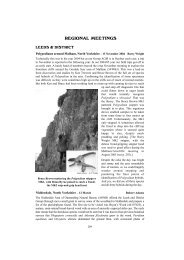Full Contents as pdf File - Natural History Museum
Full Contents as pdf File - Natural History Museum
Full Contents as pdf File - Natural History Museum
Create successful ePaper yourself
Turn your PDF publications into a flip-book with our unique Google optimized e-Paper software.
natural history departments to South Kensington in 1881 and their official separation from<br />
the British <strong>Museum</strong> in 1963. Alison went on to describe the history of the botanical<br />
collections, including the substantial boosting of the pteridophyte collection with the<br />
acquisition of John Smith’s personal herbarium. Both Kew and The <strong>Natural</strong> <strong>History</strong><br />
<strong>Museum</strong> now have a very large number of fern specimens (over 250,000 each), with more<br />
being acquired each year. There is a large backlog of specimens awaiting incorporation into<br />
the herbarium, and Alison’s retirement goal had been to complete this project. However,<br />
<strong>as</strong>suming the current annual rate of incorporation of about 2,000 specimens and <strong>as</strong> there are<br />
currently 69,000 awaiting attention, the realisation h<strong>as</strong> dawned that this goal may be<br />
unattainable! Alison continued her history by recounting the locations of the Cryptogamic<br />
Herbarium, showing a picture of the flowering plant herbarium, which then occupied the<br />
present site of ‘the crypt’, following the incendiary bomb damage in 1941, and a further<br />
picture in the less cluttered days of 1968.<br />
The landmark publication A new generic sequence for the pteridophyte herbarium by<br />
Crabbe, Jermy and Mickel in 1975 provides the filing arrangement in use in the herbarium,<br />
though this h<strong>as</strong> been modified over the years.<br />
The herbarium is a rich source of historical and distributional information. It is most helpful<br />
to have more than one specimen of a species in order to demonstrate variation, and provide<br />
potential source material should a species be split. However, there had been over-zealous<br />
collection of some species, and Alison showed a picture of a herbarium sheet of<br />
Ophioglossum lusitanicum containing over 100 specimens. This w<strong>as</strong> clearly over the top, and<br />
to be deplored on conservation grounds. To be of value, the herbarium should be used <strong>as</strong> much<br />
<strong>as</strong> possible, and this w<strong>as</strong> now being further facilitated through the modern concept of the<br />
‘virtual herbarium’ – i.e. making datab<strong>as</strong>es and images of specimens available via the Internet.<br />
Alison then described the acquisition process. All specimens are frozen on arrival to kill<br />
insect pests, which can be a problem in temperate climates (but are a far greater problem in<br />
the tropics). In addition to her fern herbarium responsibilities, Alison also co-ordinates<br />
Integrated Pest Management for the whole department! Following datab<strong>as</strong>ing (and labelling<br />
if necessary), acquisitions are ‘laid out’, a process requiring a combination of artistic and<br />
practical skills and understanding of the plants. The importance of this stage w<strong>as</strong><br />
demonstrated by examples of both good and poor layouts. Next comes mounting with glue<br />
and linen straps. Although the main collection is in the form of specimens mounted on<br />
paper, there is also a collection of ferns preserved in ‘fern pickle’ (a concoction b<strong>as</strong>ed on<br />
industrial methylated spirits), a useful preservation medium where sectioning for<br />
microscopic examination is required. Finally, Alison showed us her job description, which<br />
did not seem to allow any time for eating and sleeping!<br />
Fred Rumsey commenced his talk ‘What is a species?’ by highlighting how controversial a<br />
discussion point this can be! Compared to some other plants, however, fern entities have<br />
remained relatively stable. Fred’s view is that the species concept ‘generally works’, but is<br />
more difficult to actually define. Particular difficulties arise when considering/anticipating<br />
the p<strong>as</strong>t/present/future evolutionary changes that an entity can undergo. Historically, species<br />
were defined by the morphological similarities between specimens. However, in the 1950s<br />
Ernst Mayr introduced the biological species concept of interbreeding natural populations.<br />
Unfortunately, difficulties can arise with this over a geographical continuum of closely<br />
related interbreeding populations. For example, spread across a continent, A can breed with<br />
B which can breed with C which can breed with D, but A cannot breed with D. Another<br />
‘problem’ with Mayr is that 10% of ferns are apomictic, and so do not ‘interbreed’. Another<br />
example of why the morphological concept does not always work w<strong>as</strong> provided by the<br />
Athyrium flexile and A. distentifolium situation, two morphotypes looking different, but in<br />
fact being interfertile examples of what must be considered a single species<br />
116

















